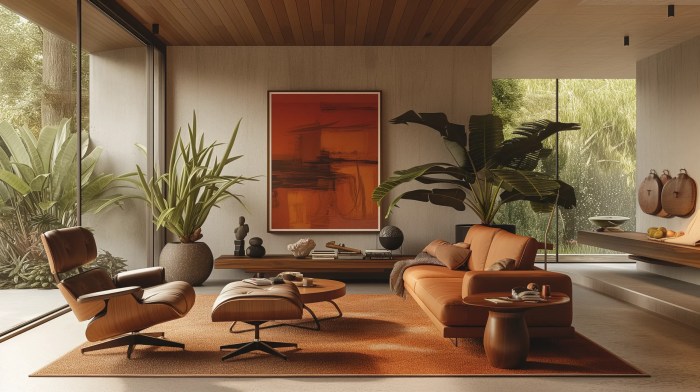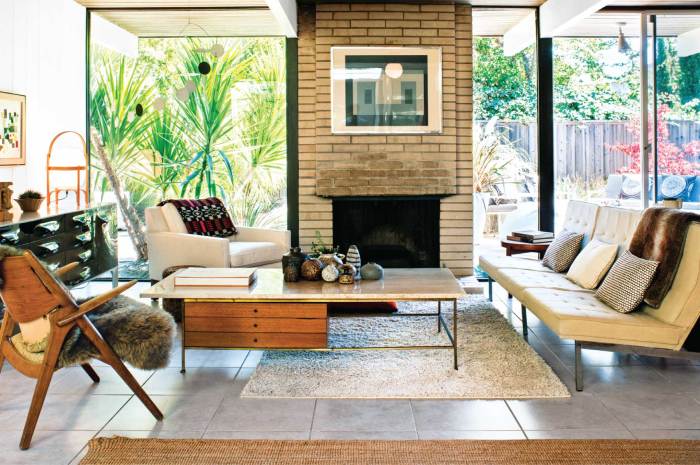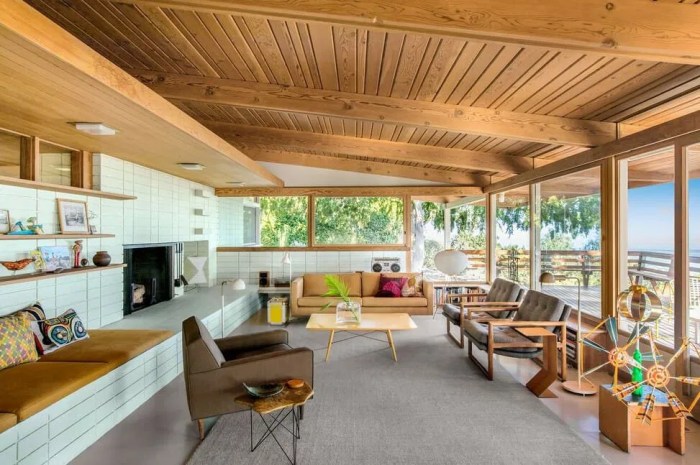Embark on a fascinating exploration of mid century interior design, delving into its rich history, defining characteristics, and enduring influence on modern aesthetics. From iconic furniture pieces to color palettes, this topic offers a captivating glimpse into a design era that continues to inspire creativity and innovation.
Definition of Mid-Century Interior Design

Mid-century interior design refers to a design style that emerged in the mid-20th century, roughly from the 1930s to the 1960s. It is characterized by clean lines, minimal ornamentation, and a focus on functionality and simplicity. This design movement was influenced by the post-World War II era and the desire for modern, practical living spaces.
Key Characteristics of Mid-Century Interior Design
- Clean Lines: Mid-century design emphasizes sleek, straight lines in furniture and architecture, creating a sense of simplicity and elegance.
- Organic Shapes: The use of organic, natural shapes and materials such as wood, leather, and metal is a common feature in mid-century interiors.
- Functionality: Mid-century designers prioritized functionality and practicality in their designs, often incorporating multi-purpose furniture and efficient layouts.
Influence of Mid-Century Designers
- Charles and Ray Eames: Known for their iconic furniture pieces such as the Eames Lounge Chair, the Eameses were influential in shaping mid-century design with their innovative use of materials and focus on comfort.
- Eero Saarinen: Saarinen's designs, including the Tulip Chair and Tulip Table, embraced organic forms and clean lines, becoming synonymous with mid-century modern style.
- Arne Jacobsen: Jacobsen's work, like the Egg Chair and Swan Chair, showcased his minimalist approach and attention to detail, contributing to the popularity of mid-century design.
Color Palette in Mid-Century Interior Design

Mid-century interior design is known for its distinctive color palette that reflects the era's aesthetic. The color choices play a crucial role in capturing the essence of mid-century modern style.
Typical Color Palette
- Earth Tones: Mid-century interiors often feature warm earthy colors like olive green, mustard yellow, burnt orange, and brown. These hues bring a sense of nature indoors.
- Muted Shades: Soft pastel colors such as pale pink, baby blue, and mint green are also commonly used in mid-century design to create a calming and inviting atmosphere.
- Pops of Bright Colors: Vibrant hues like teal, turquoise, and red are used sparingly to add a playful and energetic touch to the overall design.
Significance of Colors
The colors in mid-century interior design are carefully chosen to evoke a feeling of nostalgia for the post-war optimism of the 1950s and 1960s. They help to create a sense of balance, harmony, and warmth in the space.
Incorporating Mid-Century Color Scheme
To incorporate a mid-century color scheme into modern interiors, you can start by painting walls in earthy tones and using furniture pieces in muted shades. Adding accent pieces in bright colors like throw pillows, artwork, or decorative objects can instantly elevate the space with a mid-century flair.
Furniture and Decor Elements

Mid-century interior design is characterized by iconic furniture pieces that have stood the test of time. These pieces often combine form and function seamlessly, creating a timeless appeal in any space.Organic materials play a significant role in mid-century furniture, adding warmth and texture to the design.
Wood, leather, and metal are commonly used to create pieces that exude a sense of craftsmanship and quality.
Iconic Furniture Pieces
- The Eames lounge chair and ottoman: A classic mid-century piece that embodies comfort and style.
- The Noguchi table: Known for its sculptural base and glass top, adding a touch of elegance to any room.
- The Saarinen Tulip table: Featuring a sleek, modern design that complements a variety of decor styles.
Use of Organic Materials
Mid-century furniture often incorporates organic materials such as wood, leather, and metal to create pieces that are both stylish and durable. These materials add warmth and texture to the design, enhancing the overall aesthetic of the space.
Mixing Vintage with Modern Decor
One way to achieve a cohesive look in your space is by mixing vintage mid-century pieces with modern decor. By combining old and new elements, you can create a unique and eclectic style that showcases your personal taste and design aesthetic.
Layout and Spatial Arrangement
Mid-century interior design is known for its open floor plans and seamless transition between indoor and outdoor spaces. The layout and spatial arrangement play a crucial role in creating the iconic mid-century modern look.
Emphasis on Indoor-Outdoor Living
Mid-century homes often feature large windows, sliding glass doors, and outdoor patio areas that blur the lines between indoor and outdoor spaces. This design element allows natural light to flood the interior and creates a strong connection to the surrounding landscape.
Importance of Natural Light
Natural light is a key element in mid-century interior design as it enhances the overall ambiance of the space. Large windows, clerestory windows, and skylights are commonly used to bring in as much natural light as possible. This not only brightens up the space but also highlights the clean lines and minimalist aesthetic of mid-century furniture and decor.
Arranging Furniture
When arranging furniture in a mid-century modern layout, it's important to focus on functionality and flow. Here are some tips:
- Place furniture away from the walls to create a more intimate seating arrangement.
- Opt for low-profile furniture with clean lines to maintain the mid-century modern aesthetic.
- Use a mix of materials like wood, metal, and leather to add texture and visual interest.
- Consider the traffic flow and ensure there is enough space to move around comfortably.
- Integrate statement pieces like a bold-colored sofa or a unique coffee table to add a touch of personality to the space.
Final Thoughts
In conclusion, mid century interior design encapsulates a timeless blend of form and function, offering a unique perspective on interior aesthetics that resonates with design enthusiasts and homeowners alike. As we reflect on the key elements and principles of this design movement, it becomes evident that its impact on contemporary spaces remains both relevant and revered.
FAQ Corner
What defines mid-century interior design?
Mid-century interior design is characterized by clean lines, organic shapes, and a focus on functionality, reflecting the design ethos of the mid-20th century.
How can I incorporate a mid-century color palette into my home?
To infuse your space with mid-century style, opt for earth tones, muted shades, and pops of bright colors to create a harmonious and inviting atmosphere.
Which iconic furniture pieces are synonymous with mid-century interiors?
Pieces like the Eames lounge chair and Noguchi table are iconic examples of mid-century furniture known for their timeless appeal and innovative design.
Why is natural light important in mid-century interior design?
Natural light enhances the spacious and airy feel of mid-century spaces, emphasizing the connection between indoor and outdoor living that defines this design style.
